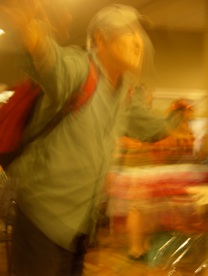
Bioregionalism
In your own words,
how would you briefly define bioregionalism?
“Understanding what plants & animals exist in our bioregion and what watershed provides for all within that area. Getting together with others who are interested in learning more and sharing more about how to preserve what nature gives us.”
“Region-specific biological conservation goals and gains. Reinhabitory, all-species belief, evangelism, attitude, focus, bias, perspective, analysis or critique guiding one's personal lifestyle and consumption; family, cultural, community and economic behaviors; local, urban, regional, national, hemispheric and foreign affinities, politics and policies.”
“Bioregions, conceptually, are the moving fluid land that encompasses the globe, irrespective of artificial situations such as cities, states, and countries.”
“As the overall pattern of nature and its animals, people, culture characteristics, that are found in a specific place, and live in a sustainable way naturally.”
” I usually think of my bioregion as defined by my watershed. Bioregionalism, therefore, is the development of complex systems that support all life within that bioregion first, but also extended out ultimately to include the entire planet.”
” Creating a sense of place. Learning to live where you are. Making economic and ecological decisions with the intention of creating a healthy local system.”
“Using natural divisions between ecological systems as a guide to identifying human ranges.”
“Living in place – developing communities integrated with the ecosystems from which they spring”
“Orienting your life based on natural and living systems instead of artificial means devised by man and cultural.”
“The art of living in place”
“Learning the characteristics of the biome where you live and learning to live there in harmony with the rest of the species.”
“Regions that share natural resources and geography --divisions made based on nature rather than arbitrary county, state, or country lines drawn by government”
“Living in place, knowing and honoring the natural limits and resources of the place you call home.”
“Umbrella under which, different movements, groups, individuals bioregionally conscious, are working to build the bases of a Culture of Peace.”
“The intent to, within the context of a bioregion (or a continent or planet), develop a working ecological economy as derived from an understanding of how the collectivity of intact ecological systems of the region have through time -- including before and during human habitation -- comprised what is in all significant respects a fulfilling functioning solar/photosynthetic "economy" that provides original templates enabling the generation of ecological design modalities for configuring/re-configuring all human activities in at least 28 essential sectors, including the coordination of the economy through such mediums as bioregional congresses.”
“Bioregionalism is empowering ourselves to create positive change in our communities and increase our independency from government and infrastructure providing our needs.”
“Bioregionalism means taking where you live seriously and getting together with other people to preserve it.”
“The concept that people acting within the defining parameters of their natural region in accordance with natural ecological law can help reconfigure human culture to be sustainable and nourishing”.
“Learning the wisdom of place and reinhabiting the local ecosystems in order to live sustainably with our other specied kin.”
“Movement of local immersion and social, ecological and economical embeddedness”.
“Bioregionalism is a political, cultural, and environmental system based on naturally-defined areas (bioregions) which are defined through physical and environmental features, including watershed boundaries and soil and terrain characteristics rather than geographic and political boundaries. The determination of a bioregion is also a cultural phenomenon, and emphasizes the importance of the knowledge and solutions of local human populations. Bioregionalism also recognizes nature rights and the need for humans to interact with other species in a harmonious and non-violent manner”.
- Bioregional Listserve
word for word from our Bioregional listserve:

QUOTE OF THE MOMENT:
David Haenke:
The prime example of
"successful community-based initiatives through contemporary watershed
organizations and programs (in that BOTH successful ecological restoration /conservation AND grass-roots community organizing was accomplished)" is the Mattole Watershed, Mattole River, California, profoundly described in Freeman House's book Totem Salmon (which I refer to as the most important writing in the last 500 years).
Nothing I'm aware of even comes close, and the Mattole experience could and should be extrapolated (in nearly all salient dimensions: political, economic, etc.) and scaled up to apply to bioregions, and geopolitical scales (as useful and necessary) of ecological organizing.
d el h
replying to
Jeffrey Mocniak
(Deschutes watershed of the Salish Sea ecoregion of the Cascadian bioregion:
“I'm in the process of researching various aspects of watershed oriented human-ecological relationships. I'm looking for information concerning the following topics:
- traditional (historical or indigenous) watershed-based territorial patterns of inhabitation:
- human shifts in patterns of land inhabitation - from ecosystem oriented patterns to the modern trends of longitude/latitude grid-like settlement and development (including the roles of land surveying and private property in this process)
- climate change adaptation (via trans-boundary watershed-based cooperation and organization)
- examples of successful community-based initiatives through contemporary watershed organizations and programs (in that BOTH successful ecological restoration/conservation AND grass-roots community organizing was accomplished)
Any books, research papers, personal stories, websites, etc that anyone could provide/point out would be most helpful.
Many thanks




sideways glance

David Haenke flying through the CBCX All-Species Ball
Our old tradition of the always burning fire depends on location, in CBCXI we will be extremely cautious to make no fires & so protect the wild vulnerable primal places in the Klamath-Siskiyou bioregion.
click here to return to OP3: http://www.ask-ssw.com/3/output_specification.html
or hop to OP4
Home Page Integrative EcoSocial Design
OP1A OP1B OP2 OP3 Links 3&4 OP4 OP5 LInks 5 Op6 LR GU
7-Year2 #1-LIPD 7-Year2 #1-LIPD Links 8-Year2 #2
Links WW 8&9 Year2 #2 & #3 9-Year2 #3 Regenerative Healing
Right Brain 10-Year2 #4 Art in earth Left Brain 10-Year2 #4 eARTh
Links 10-Year2 #4 11-Year2 #5 Nicole’s Elf reWrite 11-Year2 #5